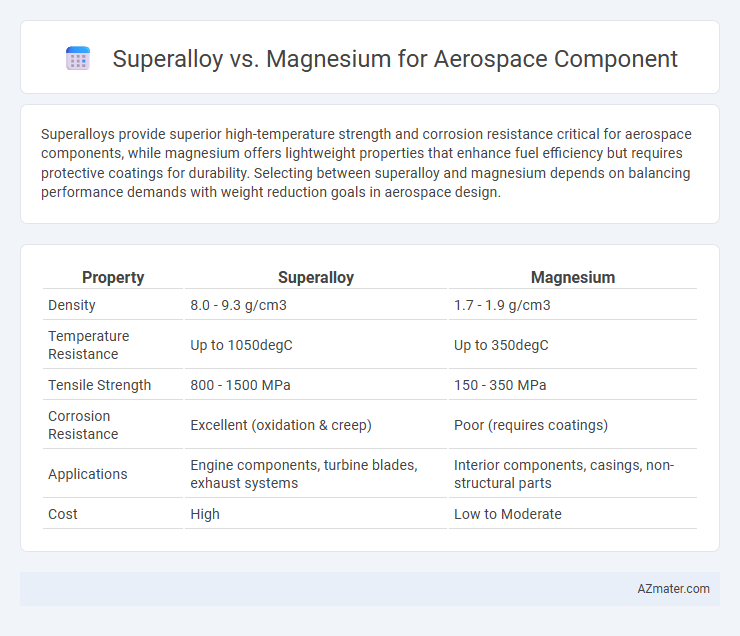Superalloys provide superior high-temperature strength and corrosion resistance critical for aerospace components, while magnesium offers lightweight properties that enhance fuel efficiency but requires protective coatings for durability. Selecting between superalloy and magnesium depends on balancing performance demands with weight reduction goals in aerospace design.
Table of Comparison
| Property | Superalloy | Magnesium |
|---|---|---|
| Density | 8.0 - 9.3 g/cm3 | 1.7 - 1.9 g/cm3 |
| Temperature Resistance | Up to 1050degC | Up to 350degC |
| Tensile Strength | 800 - 1500 MPa | 150 - 350 MPa |
| Corrosion Resistance | Excellent (oxidation & creep) | Poor (requires coatings) |
| Applications | Engine components, turbine blades, exhaust systems | Interior components, casings, non-structural parts |
| Cost | High | Low to Moderate |
Introduction to Aerospace Materials
Superalloys and magnesium alloys are critical materials in aerospace engineering, each offering distinct properties for component manufacturing. Superalloys provide exceptional high-temperature strength, corrosion resistance, and durability, making them ideal for turbine engines and structural parts subjected to extreme conditions. Magnesium alloys are valued for their lightweight characteristics, contributing to fuel efficiency and reducing overall aircraft weight, though they generally offer lower thermal and mechanical performance compared to superalloys.
Overview of Superalloys
Superalloys, primarily composed of nickel, cobalt, or iron, exhibit exceptional high-temperature strength, corrosion resistance, and creep resistance, making them indispensable for critical aerospace components such as turbine blades and jet engine parts. Their complex microstructure and alloying elements like chromium, aluminum, and titanium enable superior performance in extreme environments compared to lightweight metals like magnesium. These characteristics optimize engine efficiency, durability, and safety in aerospace applications requiring reliability under thermal and mechanical stress.
Overview of Magnesium Alloys
Magnesium alloys are prized in aerospace for their exceptional strength-to-weight ratio, making them ideal for reducing overall aircraft weight and improving fuel efficiency. These alloys exhibit excellent damping capacity and high machinability, but typically have lower corrosion resistance and temperature stability compared to superalloys. Their application is often confined to non-critical structural components where lightweight properties outweigh the limitations in strength and thermal endurance.
Key Mechanical Properties Comparison
Superalloys exhibit exceptional high-temperature strength, corrosion resistance, and creep resistance, making them ideal for critical aerospace components subjected to extreme conditions. Magnesium alloys offer a significantly lower density, enhancing fuel efficiency due to weight reduction, but generally sacrifice tensile strength and fatigue resistance compared to superalloys. When selecting materials for aerospace applications, the trade-off between superalloys' superior mechanical performance and magnesium's lightweight advantage is crucial for optimizing component durability and efficiency.
Weight and Density Considerations
Superalloys possess high density, typically around 8.0-8.5 g/cm3, which contributes to their excellent strength and temperature resistance but results in heavier aerospace components. Magnesium alloys offer a significantly lower density, approximately 1.7-1.9 g/cm3, making them ideal for weight-sensitive applications where reducing mass is critical for fuel efficiency and overall aircraft performance. Balancing material density and mechanical properties is essential in aerospace design to optimize structural integrity while minimizing weight.
Corrosion Resistance Analysis
Superalloys exhibit superior corrosion resistance in aerospace components due to their high chromium and nickel content, which forms stable oxide layers protecting against oxidation and environmental degradation. Magnesium alloys, while lightweight, are more susceptible to corrosion, especially galvanic and pitting corrosion, limiting their durability in aggressive aerospace environments. Advanced surface treatments and coatings can enhance magnesium's corrosion resistance, but superalloys remain the preferred choice for critical aerospace parts requiring long-term corrosion stability.
High-Temperature Performance
Superalloys exhibit exceptional high-temperature performance, maintaining mechanical strength and oxidation resistance well beyond 1000degC, making them ideal for critical aerospace components such as turbine blades and engine parts. Magnesium alloys, while lightweight and offering good corrosion resistance, typically degrade at temperatures above 300degC, limiting their use in high-temperature aerospace environments. The superior thermal stability and creep resistance of superalloys provide a crucial advantage for aerospace applications demanding sustained exposure to extreme heat.
Manufacturing and Machinability
Superalloys exhibit superior high-temperature strength and oxidation resistance, making them essential for aerospace components subjected to extreme conditions, but their dense microstructure complicates manufacturing and demands specialized machining techniques such as EDM or high-speed milling. Magnesium alloys provide exceptional lightweight properties and ease of machining due to their low density and high machinability index, allowing for faster production cycles and reduced tool wear, though they require careful control of flammability during manufacturing processes like casting and extrusion. Selecting between superalloys and magnesium involves balancing the need for thermal performance and mechanical integrity against manufacturing complexity and machinability efficiency in aerospace applications.
Cost Implications and Availability
Superalloys exhibit high strength and corrosion resistance at elevated temperatures, making them essential for critical aerospace components but come with higher costs due to complex manufacturing processes and expensive raw materials. Magnesium offers a lightweight alternative with lower material and production expenses, enhancing fuel efficiency and reducing overall aircraft weight; however, its limited availability and challenges in corrosion resistance may increase maintenance costs. Balancing cost implications and availability, aerospace manufacturers often select superalloys for performance-critical parts while magnesium is preferred for less demanding structural components to optimize budget and material properties.
Application Suitability and Future Trends
Superalloys offer exceptional high-temperature strength and corrosion resistance, making them ideal for turbine blades, engine components, and other critical aerospace parts subject to extreme thermal and mechanical stress. Magnesium's lightweight properties support fuel efficiency and aircraft weight reduction but face challenges in thermal stability and corrosion resistance, limiting its use to non-structural or secondary components. Future trends emphasize advanced superalloy coatings and additive manufacturing techniques to enhance performance, alongside innovative magnesium alloys and composites designed to improve durability and expand application scope in aerospace engineering.

Infographic: Superalloy vs Magnesium for Aerospace component
 azmater.com
azmater.com